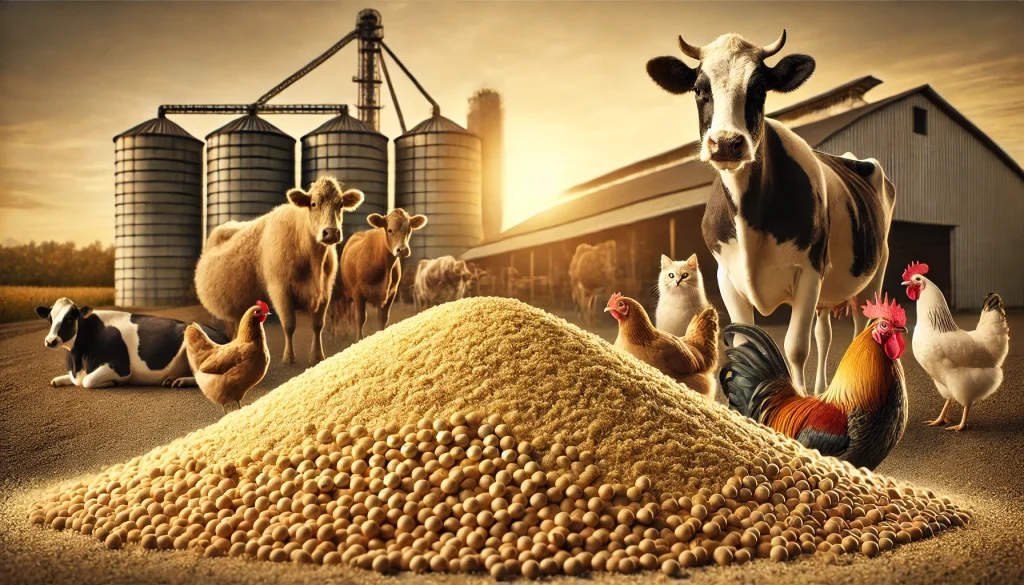
Introduction
Soybean meal is one of the most important protein sources in livestock and poultry nutrition. Due to its high nutritional value and excellent digestibility, it is widely used in the feed industry. In this article, we will comprehensively examine the characteristics of soybean meal, its benefits, chemical composition, impact on livestock and poultry growth and health, and essential considerations for its usage. Keyhan Matin Gharn, as a leading supplier of animal feed products, consistently delivers the highest quality soybean meal.
What is Soybean Meal?
Soybean meal is a by-product of soybean oil extraction and serves as a rich source of protein and essential amino acids, making it a crucial component of animal feed. Compared to other protein sources, soybean meal offers superior quality and better digestibility.
Chemical Composition of Soybean Meal
Soybean meal contains various components that make it an ideal choice for livestock and poultry feed. The table below presents its primary composition:
| Component | Amount (%) |
|---|---|
| Crude Protein | 44-48 |
| Fat | 1-3 |
| Crude Fiber | 3-7 |
| Moisture | 10-12 |
| Ash | 5-7 |
| Calcium | 0.2-0.3 |
| Phosphorus | 0.6-0.7 |
Benefits of Soybean Meal in Livestock and Poultry Diets
- Rich Protein Source: The high protein content of soybean meal promotes muscle growth and development in livestock and poultry.
- High Digestibility: Its high-quality protein is easily digested and absorbed by animals.
- Essential Amino Acid Supply: Especially lysine and methionine, which are crucial for optimal growth.
- Cost-Effective: Using soybean meal as a protein source helps reduce overall feed costs.
- Improved Meat and Egg Quality: Incorporating soybean meal into poultry diets enhances the quality of eggs and meat.
Processing and Optimization Methods for Soybean Meal
To maximize the benefits of soybean meal in livestock and poultry diets, various processing methods are employed:
- Heat Processing: Reduces anti-nutritional factors and enhances digestibility.
- Enzyme Supplementation: Improves digestibility and nutritional value.
- Blending with Other Nutrients: Ensures a balanced nutritional composition for optimal feed efficiency.
Recommended Soybean Meal Inclusion Rates in Livestock and Poultry Diets
The amount of soybean meal in animal feed varies depending on the type of livestock or poultry. The table below outlines the recommended inclusion rates:
| Animal Type | Inclusion Rate (%) |
| Laying Hens | 10-20 |
| Broilers | 20-30 |
| Dairy Cows | 10-15 |
| Beef Cattle | 15-25 |
| Sheep and Goats | 5-10 |
Key Considerations for Using Soybean Meal
- Quality Control: Ensuring high-quality soybean meal is crucial to prevent digestive issues and enhance livestock performance.
- Balanced Diet Formulation: Soybean meal should be used in conjunction with other nutrients to maintain dietary balance.
- Oxidation Prevention: Proper storage is necessary to prevent oxidation of fats and maintain nutritional value.
- Reduction of Anti-Nutritional Factors: Proper processing minimizes anti-nutritional compounds like phytates.
Conclusion
As a valuable protein source, soybean meal plays a significant role in livestock and poultry nutrition. Proper utilization and adherence to feeding principles can improve animal performance and reduce feeding costs. Keyhan Matin Gharn ensures the highest quality soybean meal, helping farmers achieve optimal results in their production. Using soybean meal not only enhances economic efficiency but also improves the quality of final products such as meat and eggs.

